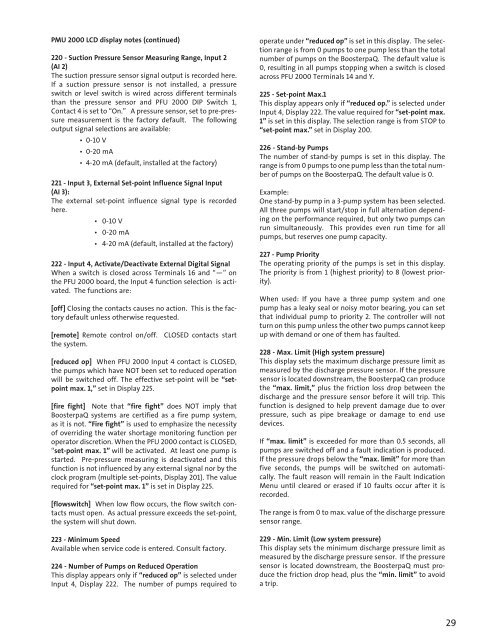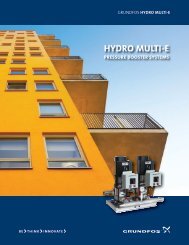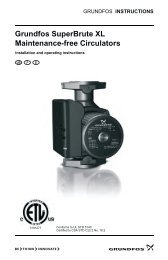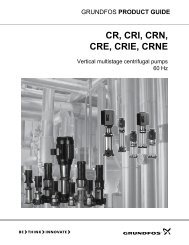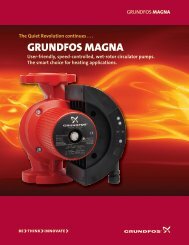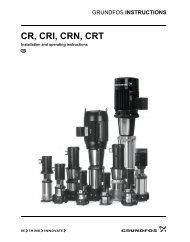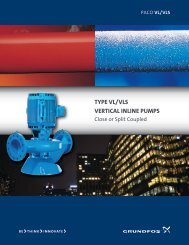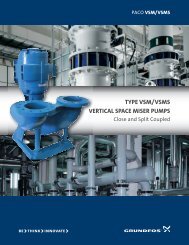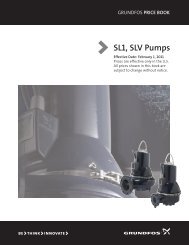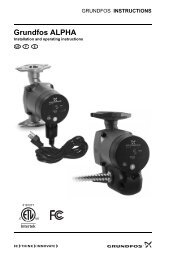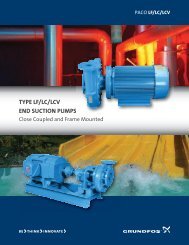BoosterpaQ® Grundfos CR-Booster Systems 60 Hz
BoosterpaQ® Grundfos CR-Booster Systems 60 Hz
BoosterpaQ® Grundfos CR-Booster Systems 60 Hz
Create successful ePaper yourself
Turn your PDF publications into a flip-book with our unique Google optimized e-Paper software.
PMU 2000 LCD display notes (continued)<br />
220 - Suction Pressure Sensor Measuring Range, Input 2<br />
(AI 2)<br />
The suction pressure sensor signal output is recorded here.<br />
If a suction pressure sensor is not installed, a pressure<br />
switch or level switch is wired across different terminals<br />
than the pressure sensor and PFU 2000 DIP Switch 1,<br />
Contact 4 is set to “On.” A pressure sensor, set to pre-pressure<br />
measurement is the factory default. The following<br />
output signal selections are available:<br />
• 0-10 V<br />
• 0-20 mA<br />
• 4-20 mA (default, installed at the factory)<br />
221 - Input 3, External Set-point Influence Signal Input<br />
(AI 3):<br />
The external set-point influence signal type is recorded<br />
here.<br />
• 0-10 V<br />
• 0-20 mA<br />
• 4-20 mA (default, installed at the factory)<br />
222 - Input 4, Activate/Deactivate External Digital Signal<br />
When a switch is closed across Terminals 16 and “—” on<br />
the PFU 2000 board, the Input 4 function selection is activated.<br />
The functions are:<br />
[off] Closing the contacts causes no action. This is the factory<br />
default unless otherwise requested.<br />
[remote] Remote control on/off.<br />
the system.<br />
CLOSED contacts start<br />
[reduced op] When PFU 2000 Input 4 contact is CLOSED,<br />
the pumps which have NOT been set to reduced operation<br />
will be switched off. The effective set-point will be “setpoint<br />
max. 1,” set in Display 225.<br />
[fire fight] Note that “fire fight” does NOT imply that<br />
<strong>Booster</strong>paQ systems are certified as a fire pump system,<br />
as it is not. “Fire fight” is used to emphasize the necessity<br />
of overriding the water shortage monitoring function per<br />
operator discretion. When the PFU 2000 contact is CLOSED,<br />
“set-point max. 1” will be activated. At least one pump is<br />
started. Pre-pressure measuring is deactivated and this<br />
function is not influenced by any external signal nor by the<br />
clock program (multiple set-points, Display 201). The value<br />
required for “set-point max. 1” is set in Display 225.<br />
[flowswitch] When low flow occurs, the flow switch contacts<br />
must open. As actual pressure exceeds the set-point,<br />
the system will shut down.<br />
223 - Minimum Speed<br />
Available when service code is entered. Consult factory.<br />
224 - Number of Pumps on Reduced Operation<br />
This display appears only if “reduced op” is selected under<br />
Input 4, Display 222. The number of pumps required to<br />
operate under “reduced op” is set in this display. The selection<br />
range is from 0 pumps to one pump less than the total<br />
number of pumps on the <strong>Booster</strong>paQ. The default value is<br />
0, resulting in all pumps stopping when a switch is closed<br />
across PFU 2000 Terminals 14 and Y.<br />
225 - Set-point Max.1<br />
This display appears only if “reduced op.” is selected under<br />
Input 4, Display 222. The value required for “set-point max.<br />
1” is set in this display. The selection range is from STOP to<br />
“set-point max.” set in Display 200.<br />
226 - Stand-by Pumps<br />
The number of stand-by pumps is set in this display. The<br />
range is from 0 pumps to one pump less than the total number<br />
of pumps on the <strong>Booster</strong>paQ. The default value is 0.<br />
Example:<br />
One stand-by pump in a 3-pump system has been selected.<br />
All three pumps will start/stop in full alternation depending<br />
on the performance required, but only two pumps can<br />
run simultaneously. This provides even run time for all<br />
pumps, but reserves one pump capacity.<br />
227 - Pump Priority<br />
The operating priority of the pumps is set in this display.<br />
The priority is from 1 (highest priority) to 8 (lowest priority).<br />
When used: If you have a three pump system and one<br />
pump has a leaky seal or noisy motor bearing, you can set<br />
that individual pump to priority 2. The controller will not<br />
turn on this pump unless the other two pumps cannot keep<br />
up with demand or one of them has faulted.<br />
228 - Max. Limit (High system pressure)<br />
This display sets the maximum discharge pressure limit as<br />
measured by the discharge pressure sensor. If the pressure<br />
sensor is located downstream, the <strong>Booster</strong>paQ can produce<br />
the “max. limit,” plus the friction loss drop between the<br />
discharge and the pressure sensor before it will trip. This<br />
function is designed to help prevent damage due to over<br />
pressure, such as pipe breakage or damage to end use<br />
devices.<br />
If “max. limit” is exceeded for more than 0.5 seconds, all<br />
pumps are switched off and a fault indication is produced.<br />
If the pressure drops below the “max. limit” for more than<br />
five seconds, the pumps will be switched on automatically.<br />
The fault reason will remain in the Fault Indication<br />
Menu until cleared or erased if 10 faults occur after it is<br />
recorded.<br />
The range is from 0 to max. value of the discharge pressure<br />
sensor range.<br />
229 - Min. Limit (Low system pressure)<br />
This display sets the minimum discharge pressure limit as<br />
measured by the discharge pressure sensor. If the pressure<br />
sensor is located downstream, the <strong>Booster</strong>paQ must produce<br />
the friction drop head, plus the “min. limit” to avoid<br />
a trip.<br />
29


